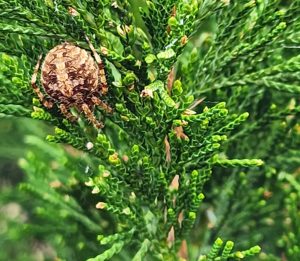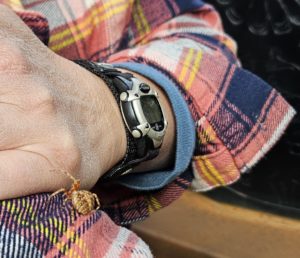The Spotted Orbweaver: Nature’s Web-Building Wonder
Neoscona crucifera, commonly known as the Spotted Orbweaver or Cross Orbweaver, due to the cross-shaped marking on its abdomen. This impressive species is found across much of the United States. These spiders are extraordinary not only for their web-building skills but also for their contribution maintaining balanced ecosystems, not unlike most spiders.

Photo by Christie Collins
Physical Features and Variations
Females, the larger of the sexes, can measure up to 19 mm in length, while males can be half the size and differs slightly in appearance. The spider’s body appears very hairy with spikey brown hairs covering its entire body including its legs. The legs exhibit alternating light and dark brown bands. Its coloration can range from rusty-red to golden orange, making it fantastically camouflaged into woodland surroundings. The underside of the abdomen is typically black with two distinct white spots, a key feature for identifying the species.
Habitat and Web Construction
Spotted Orbweavers are most commonly found in open woodlands, deciduous forests, but also may be found in suburban areas, in shrubs and on manmade structures. They build large, circular orb-shaped webs, sometimes reaching up to two feet in diameter, often near outdoor lights where prey is abundant. These spiders are primarily nocturnal but may become active during the day in the fall. Oftentimes they will take their webs down in the morning, consuming the silk, then rebuilding their web again in the evening.
Reproduction and Lifecycle
Females construct egg sacs with up to 1,000 eggs, ensuring the species’ survival through the colder months. After laying their eggs, females usually die with the first frost, leaving their eggs to overwinter and hatch in the spring. Overwintering eggs is just one important reason for not clearing out leaves and pruning back shrubs.

Photo by Jan Walton
Ecological Importance
As natural pest controllers, Neoscona crucifera helps manage insect populations. And while humans tend to make pests of themselves at times for the crafty orbweaver, they may bite if they feel threatened. No worries though, their venom is not dangerous to humans, making them a harmless and fascinating species to observe.
The Spotted Orbweaver reminds us of the beauty and importance of spiders in nature. Take some time to admire the art of their web, the intricate beauty of it shimmering in the sunlight. You can also stop to appreciate the insects they may have captured in their web, saving you from having to deal with them in your home.
Article by Christie Collins


